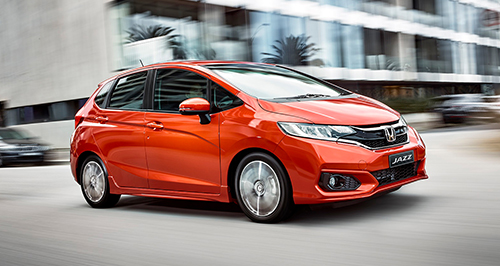Make / Model Search
News - HondaHonda confirms new platform for 2020Ground up: Honda’s new-generation Jazz is not only expected to sit on Honda’s new global architecture but also gain a new compact hybrid powertrain and the latest Honda Sensing safety systems. Jazz likely to debut new Honda Architecture when it steps out at Tokyo motor show13 May 2019 HONDA’S fourth-generation Jazz light hatchback is the most likely candidate to debut the Japanese company’s new global modular architecture when it enters showrooms in 2020.
President and CEO Takahiro Hachigo has confirmed that the platform – dubbed Honda Architecture – is already under development and will go into production under a global model to be launched next year.
He said the new platform would share more components across models and help Honda to cut the manhours required to develop new mass-selling models by 30 per cent by 2025 as it strives to streamline its operations.
“We will repurpose those manhours to accelerate our research and development in advanced areas for the future,” he said. “In this way, we can continue creating new technologies which will support the future of Honda.”
Honda Architecture is seen as the company’s answer to similar modular platforms such as Volkswagen’s MQB and Toyota’s TNGA.
The company will also reduce the numbers of variants of each model by two-thirds to simplify development and production to improve efficiency, while at the same time cutting down on the number of regional models by basing them on global vehicles.
Mr Hachigo said that as the number of trim levels and options for each model had grown, Honda had become more inefficient.
He did not name the first model to benefit from the new architecture, but the ageing Jazz – known in some markets as the Fit – would seem to be logical.
Mr Hachigo confirmed that the new Jazz would make its appearance at the Tokyo motor show in October, and would include a newly developed, more compact version of Honda’s latest two-motor hybrid powertrain.
“In addition to the expansion of the line-up of products equipped with the two-motor hybrid system, we also will expand the application of the two-motor hybrid system on a global basis,” he said.
“With that, by 2022, we are expecting to reduce the cost of the two-motor hybrid system by 25 per cent compared to the cost of this system in 2018.”
Along with the new hybrid powertrain and modular platform, the new Jazz is expected to get the Honda Sensing safety suite.
Mr Hachigo said Honda’s global models – Civic, Accord, CR-V, Fit/Jazz and Vezel/HR-V – accounted for 60 per cent of global Honda vehicle sales.
All of these models are expected to benefit from the modular platform and i-MMD (intelligent multi-motor drive) hybrid system that will be Honda’s main focus in electrifying its range to meet new fuel efficiency demands.
However, Honda will launch full-electric vehicles, starting with the Honda e city runabout that goes into production late this year.
Mr Hachigo said Honda would continue to focus on production efficiency which – outside China – was now running at 90 per cent.
He said the goal was to lift that to 100 per cent – full capacity – by 2022.
“By implementing these initiatives to increase production efficiency in each region, we are expecting to reduce global cost in the area of production by 10 per cent by 2025, compared to the cost recorded in 2018,” he said.
Honda recently reported that its operating profit declined 13 per cent for the financial year ended March 31, on foreign exchange losses, rising incentives and one-time costs to restructure its European business, even as global sales increased 2.5 per cent, to 5.3 million vehicles.  Read more1st of March 2019  Geneva show: Honda EV confirmed for 2019 productionHonda e Prototype electric hatchback set for production, Australian launch unlikely28th of February 2019  New-look Honda Civic sedan gets safety boostHonda Sensing technology made standard on fresh-faced Civic VTi-L and RS sedans |
Click to shareHonda articlesResearch Honda Motor industry news |











Facebook Twitter Instagram